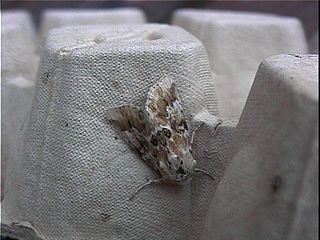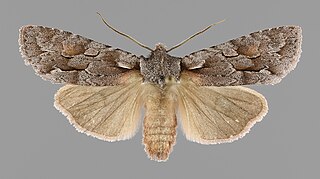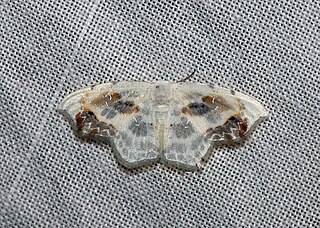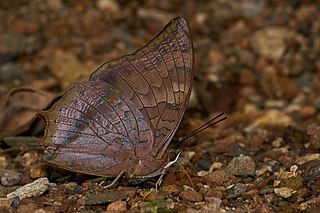
Xanthia gilvago, the dusky-lemon sallow, is a moth of the family Noctuidae. The species was first described by Michael Denis and Ignaz Schiffermüller in 1775. It is found in Europe.

Eremobia ochroleuca, the dusky sallow, is a moth of the family Noctuidae. It is found in Central and Southern Europe and the Middle East.

Cucullia argentea, the green silver-spangled shark, is a moth of the family Noctuidae. The species was first described by Johann Siegfried Hufnagel in 1766. It is found in southern and central Europe through Siberia, Mongolia and Manchuria up to Korea and Japan.

Grammodes stolida, the geometrician, is a moth of the family Erebidae. The species was first described by Johan Christian Fabricius in 1775. It is found in Africa, southern Europe, most of Asia and Australia. It migrates to central and northern Europe as far north as England, Denmark and Finland.

The lesser-spotted pinion is a moth of the family Noctuidae. It is found in central and southern Europe, north to Great Britain, Denmark, southern Sweden up to Saint Petersburg. East, its range extends through northern and Central Asia up to Japan. It is also found in north-western Africa.

Lithophane lamda, the nonconformist, is a moth of the family Noctuidae. It is found throughout Europe, except in southern Europe. It is also absent from Iceland and Ireland.

Nycteola revayana, the oak nycteoline, is a moth of the family Nolidae. The species was first described by Giovanni Antonio Scopoli in 1772. It is found from Europe and east across the Palearctic to Japan and India.

Chilo suppressalis, the Asiatic rice borer or striped rice stemborer, is a moth of the family Crambidae. It is a widespread species, known from Iran, India, Sri Lanka, China, eastern Asia, Japan, Taiwan, Malaysia to the Pacific.

Callidrepana patrana is a moth in the family Drepanidae. It was described by Frederic Moore in 1866. It is found in Nepal, India, Cambodia, Sri Lanka, Thailand, mainland China, Japan and Taiwan.
Chilo ceylonica is a moth in the family Crambidae. It was described by George Hampson in 1896. It is found in Sri Lanka, Vietnam and Hainan, China.
Auzata ocellata is a moth in the family Drepanidae. It was described by Warren in 1896. It is found in northern India, northern Myanmar and Fujian in China.
Euphalacra nigridorsata is a moth in the family Drepanidae. It was described by Warren in 1897. It is found in the north-eastern Himalayas.

Leucoblepsis renifera is a moth in the family Drepanidae. It was described by Warren in 1900. It is found on Peninsular Malaysia, Sumatra and Borneo.
Nordstromia humerata is a moth in the family Drepanidae. It was described by Warren in 1896. It is found in north-eastern India.
Callidrepana amaura is a moth in the family Drepanidae first described by Warren in 1901. It is found in Nigeria.
Callidrepana micacea is a moth in the family Drepanidae first described by Francis Walker in 1862. It is found in the north-eastern Himalayas, on the Andamans, Peninsular Malaysia, Sumatra, Borneo, the Philippines and Sulawesi.
Gogana abnormalis is a moth in the family Drepanidae first described by Warren in 1897. It is found on Borneo, Sumatra and Peninsular Malaysia.
Oreta unilinea is a moth in the family Drepanidae. It was described by William Warren in 1899. It is found in New Guinea, where it is known from Papua and Roon Island.

Charaxes borneensis,the White Banded Rajah, is a butterfly in the family Nymphalidae. It was described by Arthur Gardiner Butler in 1869. It is found in the Indomalayan realm.

Charaxes psaphon, plain tawny rajah, is a butterfly in the family Nymphalidae. It was described by John Obadiah Westwood in 1847. It is found in the Indomalayan realm.











